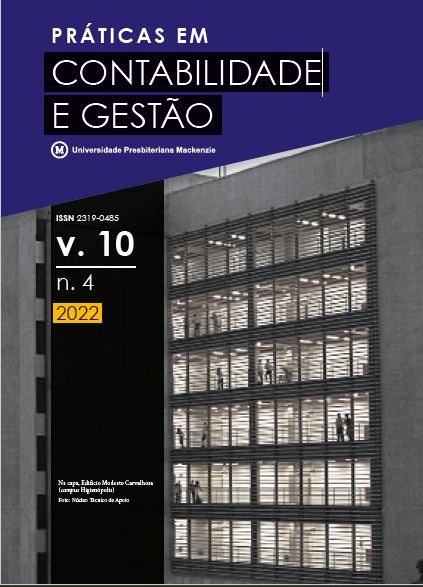USO DE FERRAMENTA DE NUDGE DIGITAL PARA O PROCESSO DA CADEIA DE SUPRIMENTOS
Relato Tecnológico
Palavras-chave:
Arquitetura de decisão, Nudges, Ocupação de veículosResumo
O objetivo deste estudo foi promover uma intervenção em um processo de carregamento de veículos em uma empresa multinacional atuante no ramo de venda de cafés torrados e moídos, esta intervenção tem como escopo aumentar a ocupação dos veículos carregados através de um aplicativo totalmente baseado nos conceitos de arquitetura de decisão e nudges. Além da intervenção, como objetivo a pesquisa pretendeu avaliar se na percepção dos principais envolvidos a proposta seria efetiva no aumento de ocupação dos baús de veículos, como resultados foi identificado que há a percepção de auxílio para melhora da performance, mas além disso, que a aplicação da ferramenta atende aos critérios do conceito de nudge, partindo do princípio que será uma influência, e não uma imposição sistêmica.
Downloads
Referências
Berger, M., Greinacher, E., & Wolf, L. (2022). Digital Nudging to Promote Energy Conservation Behavior: Framing and Default Rules in a Smart Home App.
Beshears, J., & Kosowsky, H. (2020). Nudging: Progress to date and future directions. Organizational behavior and human decision processes, 161, 3-19.
Creswell, J. W. (2007). Projeto de Pesquisa: método qualitativo, quantitativo e misto (2 ed.). Porto Alegre: Bookman.
Creswell, J. W. (2014). Investigação Qualitativa e Projeto de Pesquisa: Escolhendo entre Cinco Abordagens (3 ed.): Penso.
Dresch, A., Lacerda, D. P., & Antunes, J. A. V. J. (2014). Design Science Research: Método de Pesquisa para Avanço da Ciência e Tecnologia. Porto Alegre: Bookman.
Dubé, L., & Paré, G. (2003). Rigor in information systems positivist case research: Current practices, trends, and recommendations. MIS Quarterly: Management Information Systems, 27(4), 597-635. doi:10.2307/30036550
Fisher, I. (1930). Theory of interest: as determined by impatience to spend income and opportunity to invest it: Augustusm Kelly Publishers, Clifton.
Goswami, I., & Urminsky, O. (2016). When should the ask be a nudge? The effect of default amounts on charitable donations. Journal of Marketing Research, 53(5), 829-846.
Gregor, S., & Lee‐Archer, B. (2016). The digital nudge in social security administration. International Social Security Review, 69(3-4), 63-83.
Haki, K., Rieder, A., Buchmann, L., & W. Schneider, A. (2022). Digital nudging for technical debt management at Credit Suisse. European Journal of Information Systems, 1-17.
Hansen, P. G. (2016). The definition of nudge and libertarian paternalism: Does the hand fit the glove? European Journal of Risk Regulation, 7(1), 155-174.
Johnson, E. J., Shu, S. B., Dellaert, B. G., Fox, C., Goldstein, D. G., Häubl, G., . . . Schkade, D. (2012). Beyond nudges: Tools of a choice architecture. Marketing letters, 23(2), 487-504.
Keynes, J. M. (1936). The General Theory of Employment, Interest, and Money. London: Macmillan.
Lambert, D. M., & Burduroglu, R. (2000). Measuring and Selling the Value of Logistics. The International Journal of Logistics Management, 11(1), 1-18. doi:10.1108/09574090010806038
Manson, N. (2006). Is operations research really research? ORiON, 22, 155-180. doi:10.5784/22-2-40
Marconi, M. d. A., & Lokatos, E. M. (2017). Metodologia Científica (7 ed.). São Paulo: Atlas.
Mertens, S., Herberz, M., Hahnel, U. J. J., & Brosch, T. (2022). The effectiveness of nudging: A meta-analysis of choice architecture interventions across behavioral domains. Proceedings of the National Academy of Sciences, 119(1), e2107346118. doi:10.1073/pnas.2107346118
Mingers, J., & Walsham, G. (2010). Toward ethical information systems: The contribution of discourse ethics. Mis Quarterly, 833-854.
Mirsch, T., Lehrer, C., & Jung, R. (2018). Making digital nudging applicable: The digital nudge design method. Paper presented at the Proceedings of the 39th international conference on information systems (ICIS).
Rodriguez, J., Piccoli, G., & Bartosiak, M. (2019). Nudging the classroom: Designing a socio-technical artifact to reduce academic procrastination. Paper presented at the Proceedings of the 52nd Hawaii International Conference on System Sciences.
Sahin, O., Cetin, M., & Ustun, I. (2021). Detecting empty and loaded platform semi-trailers using side-fire LiDAR data for supporting freight analysis. Case Studies on Transport Policy, 9(3), 1035-1041. doi:https://doi.org/10.1016/j.cstp.2021.05.006
Sun, X., Li, X., Xiao, D., Chen, Y., & Wang, B. (2021). A Method of Mining Truck Loading Volume Detection Based on Deep Learning and Image Recognition. Sensors (Basel), 21(2). doi:10.3390/s21020635
Sunstein, C. R. (2014). Nudging: a very short guide. Journal of Consumer Policy, 37(4), 583-588.
Thaler, R. H. (2016). Behavioral economics: Past, present, and future. American economic review, 106(7), 1577-1600.
Thaler, R. H., & Sunstein, C. R. (2009). Nudge: Improving decisions about health, wealth, and happiness: Penguin.
Tobias, M., Lehrer, C., & Jung, R. (2018). Making Digital Nudging Applicable: The Digital Nudge Design Method. Paper presented at the Thirty Ninth International Conference on Information Systems, San Francisco.
Tversky, A., & Kahneman, D. (1980). The framing of decisions and the rationality of choice. Retrieved from
Van Aken, J. (2005). Management Research as a Design Science: Articulating the Research Products of Mode 2 Knowledge Production in Management. British Journal of Management, 16, 19-36. doi:10.1111/j.1467-8551.2005.00437.x
Wansink, B., Kent, R. J., & Hoch, S. J. (1998). An anchoring and adjustment model of purchase quantity decisions. Journal of Marketing Research, 35(1), 71-81.
Weiner, B. J. (2009). A theory of organizational readiness for change. Implementation Science, 4(1), 67. doi:10.1186/1748-5908-4-67
Weinmann, M., Schneider, C., & Brocke, J. v. (2016). Digital nudging. Business & Information Systems Engineering, 58(6), 433-436.
Willermark, S., & Islind, A. S. (2022). Choice architecture, friend, or foe? Future designers’ perspective on the ethics of digital nudges. Paper presented at the 13th Scandinavian Conference on Information Systems (SCIS), Helsinge, Denmark, 2022.
Yin, K. R. (2014). Estudo de caso: Planejamento e Métodos (5 ed.): Bookman.
YIN, R. K. (2015). Estudo de caso: planejamento e métodos. Porto Alegre: Bookman.
Downloads
Publicado
Como Citar
Edição
Seção
Licença
Copyright (c) 2023 Alexandre Nunes Hernandes, Evandro Henrique Ferreira Scussel, Marcio Quadros Lopes dos Santos, Sérgio Apolinário

Este trabalho está licenciado sob uma licença Creative Commons Attribution 4.0 International License. Os direitos autorais dos artigos publicados na Práticas em Contabilidade e Gestão pertencem aos autores, que concedem à Universidade Presbiteriana Mackenzie os direitos de publicação do conteúdo. Após a aprovação do artigo, os autores concedem à revista o direito da primeira publicação.




